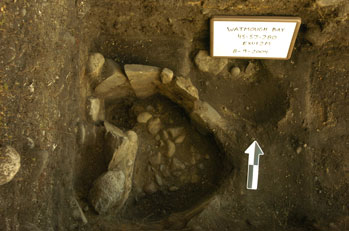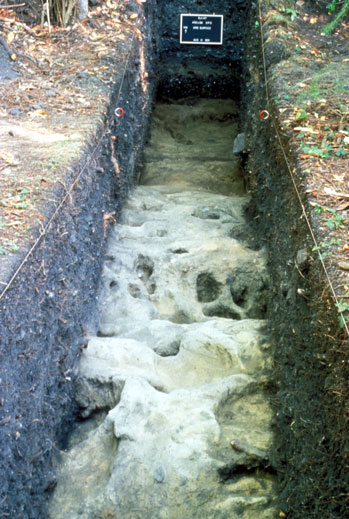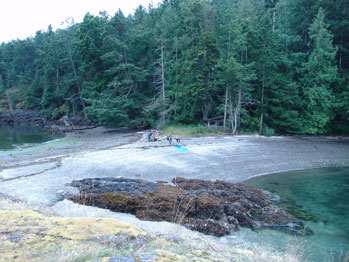Information for Prospective Geoarchaeology Graduate Students
The following comments are targeted toward people who are interested in a graduate degree at UW and want to emphasize geoarchaeology. Please use them to assess if the University of Washington is the right place for you.
This statement includes a description of the articulation of geoarchaeology to the whole archaeology program. It also includes my educational background, philosophy concerning the future of geoarchaeology, and my current research interests and field projects.

Hearth Feature at Watmough Bay
Lopez Island, WA
My Background
(back to top)
My experience in geoarchaeology began as an undergraduate when I majored in both geology and anthropology, and completed a senior honors thesis on the geoarchaeology of a site in southern Michigan. My master's degree from the University of Minnesota focused on the geoarchaeology and especially the depositional history of Nichoria, a Bronze Age site in southwestern Greece. My Ph.D. research in Kentucky focused on shell middens, emphasizing site formation processes involving sedimentation of fluvial environments and shell mounds, all in relation to the origins of agriculture. Since arriving at the University of Washington in 1980 I have continued geoarchaeological research, excavating Washington shell midden sites in the San Juan Islands and Puget Sound, and emphasizing aspects of their formation in the greater Northwest Coast. I have also continued geoarchaeological examinations of sites in other places (e.g., Belize, Monticello, Fort Clatsop), and have written papers on theoretical aspects of geoarchaeology, especially sediments and stratigraphy. My recent field work has focused on problems associated with radiocarbon dating, marine adaptation, geoarchaeology of historical sites, and influences of coastal environmental changes caused by tectonics, sea-level fluctuation, and historical landscape modification.
From 1990 to 1999 I filled a joint appointed as a professor in the Department of Anthropology and as the Curator of Archaeology to the Burke Museum of Natural History and Culture ( Burke Museum). In 1999 I accepted a position as Division Dean of Research in the College of Arts & Sciences. In 2005, because of my continued research interests in museum, I accepted the position of Director of the Burke Museum. The museum has a large collection of objects from all over the world, but especially from the Northwest. Many students work in the museum, analyzing artifacts from the Northwest and improving the storage condition of objects. I do not plan to teach for the next three years, but I will continue to meet with my students on a weekly basis. Because my time has been diverted to this new challenge, I do not plan to accept graduate students unless there is a special case where a person is dedicated to geoarchaeology and with whom I have met and discussed the excellence of fit between their interests and this institution.

Operation D Excavation at English Camp
San Juan Island , WA
The Geoarchaeology Program
(back to top)
The program here at the University of Washington is primarily a doctoral program in archaeology, with an emphasis in geoarchaeology for those that wish to pursue it. I believe firmly that geoarchaeology is really archaeology using adaptations of techniques and methods. Thus, the geoarchaeologists that come from this department examine archaeological questions by looking at sedimentological, stratigraphical, petrographic (mineralogy and petrology), geomorphological, and pedologic techniques. We are really doing archaeology, with a geological orientation.
For the first two years, all archaeology graduate students are required to take a similar set of courses. Depending on the student's background (how much statistics and anthropology they have had) some classes may differ. The basic classes are four laboratory classes (bones, ceramics, lithics, and geoarchaeology) , two or three theory classes, a quantitative methods class, and thematic and regional classes. These courses prepare students for taking the comprehensive exam that must be taken at the beginning of the seventh quarter in residence (the beginning of Autumn quarter 2 years after arriving). The exam is difficult and most students take some of spring quarter and most of the summer to prepare. Passing the comprehensive exam is the requirement for receiving a master's degree. I also require that you write some sort of research report involving an original piece of research. But after the comps are passed you are done with the official requirements for the masters degree.
Although I do not require that geoarchaeology students have geology or pedology courses before they are admitted, after the comps these students should expect to take at least 3 of the following geoscience courses (Stratigraphy, Depositional Environments, Great Geological Issues, Fluvial Geomorphology, and Geological Time) and 3 pedology courses (Soil Genesis and Classification, Field Survey of Wildland Soils, and Forest Soil Fertility and Chemistry). If you are interested in mineralogy and petrology, then optical mineralogy and work with SEM and ICP is also recommended. Students work with me to design their programs to fit individual needs and backgrounds. This program thus afford a student great flexibility, but only after they have received a heavy dose of basic archaeological theory and practical laboratory knowledge.
The Archaeological Sediment Laboratory in the department is set up to do basic chemistry, grain-size analysis, and thin-section preparation. For detailed chemical work a partnership with the sediment labs in other locations has been negotiated. This arrangement allows students access to better equipment, without depending on archaeology to pay for them. For example, we have a partnership with Material Science to use their thermal analyzer and X-Ray diffraction equipment. Earth and Space Sciences allows students access to their sample preparation facilities and isotope equipment, but a fee is arranged. As the number of geoarchaeology students grow, the demand for our laboratory equipment increases and necessary arrangements are made.
Most of our graduate students receive some sort of financial assistance or apply for financial aid in the form of work-study grants that allow students to work in our labs. The Work-Study applications must be filed in the Spring in the year before new students arrive. However, the funds are small and competition for them is great. Please discuss with me opportunities for financial assistance.
The Quaternary Research Center (QRC) here at the University of Washington is not a degree-granting department. It is a research center. Although you cannot receive a degree from the QRC, it offers many opportunities such as scholars participating in QRC seminars and lecture series. This research center gives our students exposure to the newest ideas, and collegial contacts. Obviously the QRC is a benefit to anyone interested in geoarchaeology, but not part of the official program.
If I can add any other information or answer specific questions, please let me know. I prefer to answer question on the phone (206) 543-2784 (with voice mail), but simple ones can be accommodated through email (jkstein@u.washington.edu). I look forward to speaking and meeting you, and good luck with your decision.

Auguring a Site on Shaw Island, WA

English Camp Excavation
San Juan Island, WA